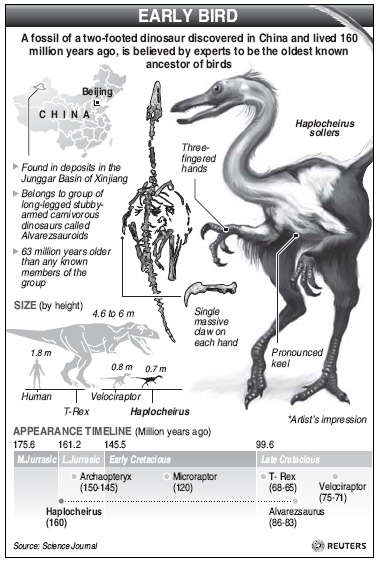Society
Fossil of 'oldest-known' bird ancestor unearthed
(China Daily)
Updated: 2010-01-30 09:06
 |
Large Medium Small |
Researchers have identified the fossil of a two-legged carnivorous dinosaur as the earliest known member of a long lineage that includes birds.

Living 160 million years ago, it was found in orange mudstone beds in the Junggar Basin in the Xinjiang Uygur autonomous region.
The "Haplocheirus sollers" had a long, narrow skull, many small teeth and powerful biceps and forelimbs, which enabled it to hunt primitive lizards, small mammals and reptiles.
The specimen, believed to be a young adult when it died, had a long tail and a body length of between 190 and 230 cm, the researchers wrote in a paper published in the journal Science.
"It had unique features but it shared some features with birds. It moved its hands sideways, like how birds can fold their wings. Its head, vertebral column, hind limbs, hands were all bird-like," said Professor Xu Xing at the Chinese Academy of Sciences' Institute of Vertebrate Paleontology and Paleonanthropology.
Xu, a member of a research team led by Jonah Choiniere at the George Washington University in Washington, said that while this species shared some features with birds, it was more like a "typical carnivorous dinosaur".
"The most salient feature of this group was their forelimb. They are predators. They had three claws on their hands, used to catch other animals. They had very bizarre forelimbs. They were very short but very stout and very strong," said Xu.
The species belonged to the family of Alvarezsauridae - a bizarre group of bird-like dinosaurs - and its discovery pushes the fossil record of this family back by 60 million years into the Late Jurassic period, or 145 million to 161 million years ago.
The Haplocheirus is about 60 million years older than the next oldest known Alvarezsauroid, which was discovered in Argentina in 1991 and lived 95 million years ago during the Cretaceous period, or 65 million to 145 million years ago.
"We know birds are derived from dinosaurs. But most of our original fossils are from the Cretaceous period," Xu said.
"Now we hope to find more Jurassic fossils. This way we can find more direct evidence to prove that birds evolved from dinosaurs."











